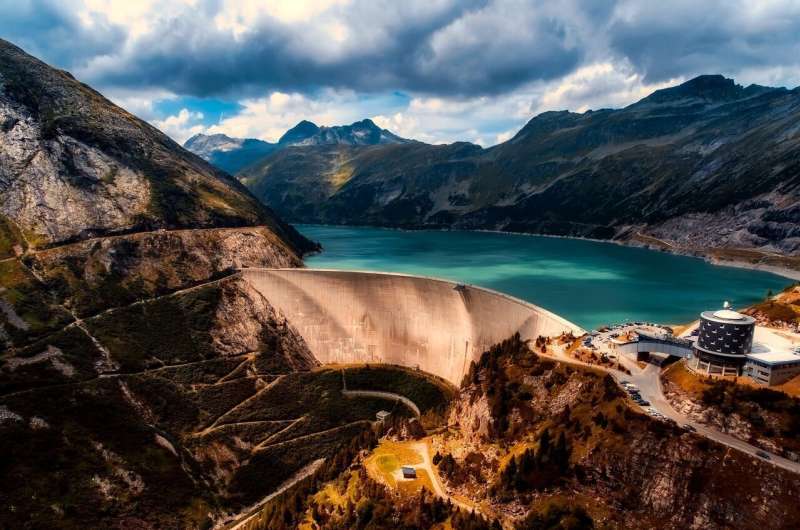Smart site selection can make hydropower greener

Even though new hydropower dam developments are intended to provide green energy, they can drown areas that are rich in plant and animal species. But this kind of collateral damage can be limited by strategic site selection, a new study shows.
In the worldwide effort to expand green, renewable energy resources, new hydropower developments have been seen as an affordable, flexible and reliable source of energy. One recent study identified nearly 2000 possible new hydropower sites that wouldn't affect existing environmental protection areas and would have affordable electricity costs. Developing these sites could almost double current global hydropower production.
But as green as hydropower may seem, it is not without environmental costs. Flooding destroys species habitat, can drown or alter rivers and streams, and the vegetation drowned by reservoirs will decompose, releasing methane, which is a powerful greenhouse gas. More methane can also affect biodiversity, because it has the potential to increase temperatures and accelerate species extinction.
Nowadays, regulators and planners are aware that hydropower reservoirs do contribute to greenhouse gas emissions, but biodiversity effects are still often overlooked. Now, a new study published in Nature Scientific Reports shows that careful selection of future hydropower projects can limit biodiversity impacts.
Big gains from careful choices
The researchers, from the Norwegian University of Science and Technology's (NTNU) Industrial Ecology Programme and the Netherlands Environment Assessment Agency and Utrecht University wanted to know where hydropower projects could be developed with the least biodiversity impact.
To find the answers, they combined a high-resolution, location-specific, technical assessment with newly developed life cycle impact assessment models to look at biodiversity impacts of hydropower projects, both for terrestrial and aquatic ecosystems.
The study uses geographical information system data to take into account the composition of existing species and local environmental conditions at each reservoir when calculating the impacts.
These tools allowed them to weigh the effects of 1938 possible future hydropower reservoirs on biodiversity impacts caused by land occupation, water consumption and methane emissions.
"Globally, 3.9% of worldwide hydropower potential accounts for 51% of terrestrial biodiversity impacts. In other words, we could avoid half of the terrestrial biodiversity impacts from new hydropower developments if we only develop the remaining 96% of the global hydropower potential," said Martin Dorber, the first author of the paper and a postdoc at NTNU.
By building only 50 percent of the global hydropower potential, 97 percent of the biodiversity impacts on terrestrial species could be eliminated, he said.
Francesca Verones, a professor at the Industrial Ecology Program and co-author of the study, said the kinds and numbers of difference species can differ radically from location to location. Computer models like the ones used for this study, have to be able to account for that variation, she said.
"It's very important to develop models that are able to assess impacts in a spatially differentiated way, because the species diversity and composition between regions is so different," she said.
Overlooking biodiversity impacts can be a problem
There were also huge differences in the scale of damage that might be caused by projected hydropower developments.
For example, the reservoir with highest terrestrial biodiversity impact had nearly 1.5 million times the impact of the reservoir with lowest terrestrial biodiversity impact, when calculated as impact per kilowatt hour (kWh) produced.
The researchers also found that there could be trade-offs when it came to impacts on terrestrial and aquatic biodiversity, because the construction of reservoirs with low terrestrial impacts will not automatically mean that the aquatic biodiversity impact will also be low, and vice versa.
When the researchers looked at the biodiversity impacts of the different projects and compared these to expected methane emissions from the reservoirs on a per kilowatt hour (kWh) basis, they found no relationship between the two.
"This means that if mitigating climate change is the main motivation for increased hydropower production, it is likely that other potential biodiversity impacts are overlooked," Dorber said.
"But it is very important to be as comprehensive as possible when it comes to assessing environmental impacts," Verones said. "There are potential trade-offs between the different sustainability development goals of the United Nations, such as providing clean and affordable energy and protecting biodiversity. If we want to minimize these trade-offs, we need to take all potential impacts into account, not just optimize for minimizing one of them."
Nevertheless, "our results show that careful selection of future hydropower reservoirs has a large potential to limit biodiversity impacts and can in turn help to achieve a more sustainable renewable energy development," Dorber said.
More information: Martin Dorber et al. Controlling biodiversity impacts of future global hydropower reservoirs by strategic site selection, Scientific Reports (2020). DOI: 10.1038/s41598-020-78444-6
Journal information: Scientific Reports
Provided by Norwegian University of Science and Technology



















